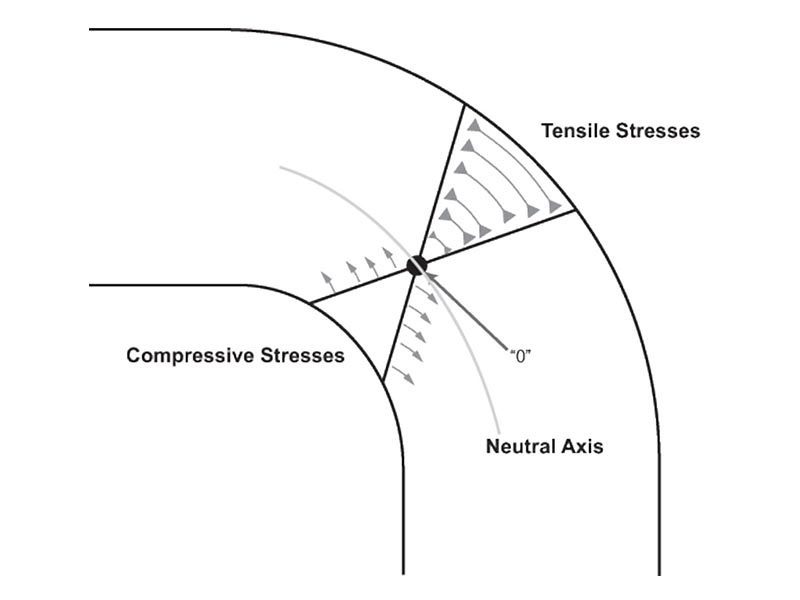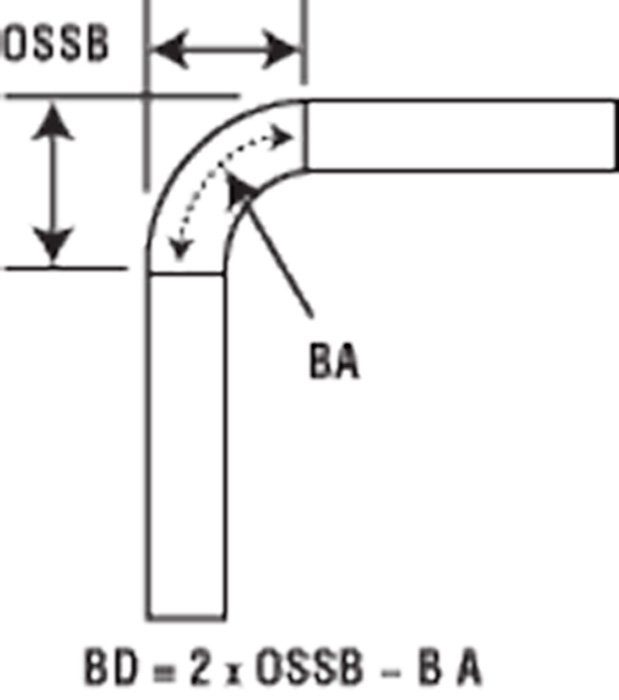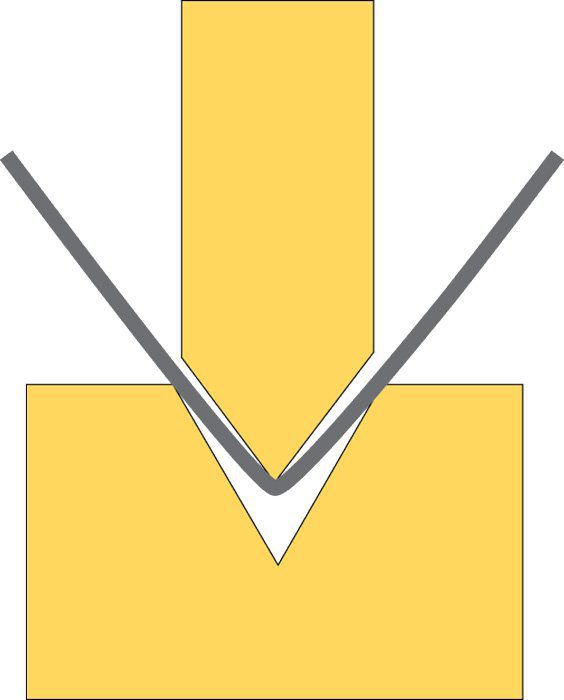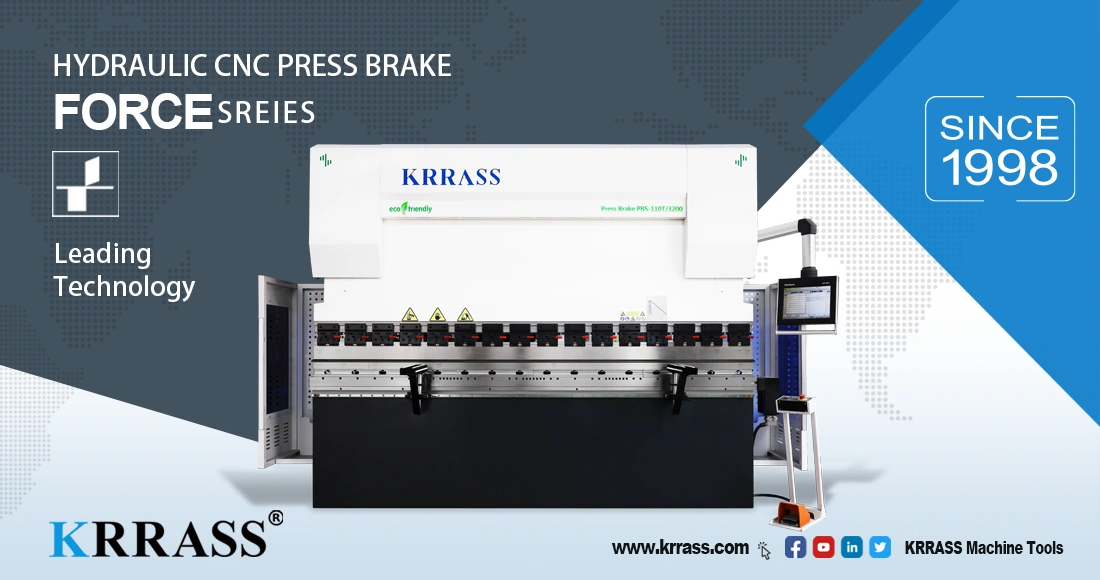Today, I will address just a few of the everyday press brake bending terms that are commonly used incorrectly. They fall into two groups. The first deals with terms associated with calculations, and the second involves words describing mechanical operations.
Group 1: Terms for Calculations
Elongation
When we talk about what happens to sheet metal during bending, we use various terms: grow, growth, expanding, stretching, stretchout, pullout, and elongation. People in the sheet metal trade use all of these terms to refer to the increase in part size caused by the bending process.
K-factor, Bend Allowance, and Bend Deduction
It is unfortunate that many of these bending terms are used interchangeably, because each has a very specific meaning and application. To be sure, all are related and do interact; nevertheless, they are all too often misused.
The K-factor is a multiplier used to determine the location of the shifted neutral axis (see Figure 1). These values can be found in Machinery’s Handbook for a variety of forming methods and materials. But for most bending calculations, we use an average K-factor of 0.446.

The bend allowance (BA) is the distance around the bend, from the tangent point between the flat and the radius on one side to the same point on the other side of the bend (see Figure 2). To calculate a flat blank (part), we add the BA to the flat dimensions on either side of the radius. And the BA incorporates the K-factor in determining its length:

BA = [(0.017453 × Inside bend radius) +[(π/180 × K-factor) × Material thickness)] ×Complementary bend angle.
The outside setback (OSSB) is used to calculate, among other things, the bend deduction (BD). The OSSB is a dimensional value that begins at the tangent of the radius and the flat of the leg on the outside surface of the bend, measuring to the apex of the bend (see Figure 2). The OSSB is often called simply “the setback,” but this can be confusing, because there is also an inside setback (ISSB), which measures along the inside tangent points and the apex of the inside mold lines. So if you mean “outside setback,” it’s always best to say “the outside setback.”
The bend deduction refers to the total amount of elongation that will occur in each bend when producing a flat pattern (see Figure 2). This value is then subtracted from the sum total of the outside dimensions, one bend deduction per bend. Note that each bend may be different from the last and, therefore, have a unique value. The BD itself is calculated by subtracting the BA from twice the OSSB.
Sharp and Minimum Inside Radius
These terms are commonly used to express the same thing, but—as you may have guessed by now—they may not be. That depends on the method of forming being performed. “Sharp” and “minimum radius” can be used interchangeably, but only when used to discuss bottom bending or coining (more on these terms later). In these cases, the punch nose radius is forced into the material. So with these bending methods, the punch nose radius value is used to compute the bend allowance, the outside setback, and the bend deduction.
When air forming, however, sharp and minimum inside radius are two entirely different things. The minimum inside radius is the smallest producible inside radius in a floated air-form. If the punch nose radius is less than that minimum floated radius, using the punch nose radius value to calculate the bend deductions will cause errors, as the punch radius is not the radius that will appear in the workpiece. To calculate a bend allowance and bend deduction that work, be sure to use the actual radius that forms in the part.
A sharp nose radius is one that applies so much piercing force that it will crease the center of the bend and cause angular and dimensional variations from deviations in the material: thickness, tensile strength, and grain direction, to name a few.
Group 2: Terms for Mechanical Operations
Some terms are different but mean the same thing. For instance, “bottoming with penetration” is just another way to say “coining.” But again, many terms are used interchangeably when they shouldn’t be, because they are very different processes.
Bottoming Versus Coining
Most use the term air bending, or air forming, correctly to describe the bending method in which the punch descends to create the bend but the part’s outside radius does not contact the die. The bend radius in air forming is “floated” as a percentage of the die width (see Figure 3).

However, the terms “bottoming” (or “bottom bending”) and “coining” are often used to describe the same thing, but they are not interchangeable as both have very precise meanings. They do share one similarity: Both bottoming and coining force the punch nose radius into the material. For this reason, you use the punch nose radius value for calculating the bend allowance and bend deduction. But this is where the similarities end.
The purpose of coining is to create a truly sharp bend: a crisp, sharp corner on the inside of the material (see Figure 4). About 50 years ago, when coining was popular, parts were “overbuilt” relative to today. Think of how heavy-duty things were built 50 years ago.

Coining puts the entire surface of the workpiece under enough heavy tonnage that it begins to “flow” or thin. This is done using a very sharp punch nose radius, such as 0.015 in. (0.381 mm), to which enough force is applied to drive the punch nose to less than the material thickness.
The punch penetrates the neutral axis and thins the material at the point of bend, leaving behind some pretty severe die markings. This process also relieves the bend of any springback, because the molecular structure has been realigned under extremely high pressure. When coining, there is no angular clearance between the punch and die, so it requires enormous pressure to stamp the radius into the part at less than the material thickness. The material’s integrity is lost to this excessive force and the resulting thinning. Any radius can be formed to less than a material thickness, but with varying results.
Unlike coining, bottoming stamps only the punch nose radius into the material (see Figure 5). On average, a bottom bend occurs at a point in the die space that’s about 20 percent above the material thickness, as measured from the bottom of the V die. Also unlike coining—which has full-face contact between the punch, workpiece, and die—bottom bending has angular clearance between the V die and punch faces, which lowers the required forming tonnage. The angular clearance also compensates for springback.

Bottom bending requires the die angle to match the intended angle of the completed bend. In most bottoming operations, an 88-degree punch angle forms a workpiece into a 90-degree die. The workpiece first bottoms against the die where the punch nose is forced into the material being formed. As the punch nose is forced against the material, the material overbends to the angle of the punch. As pressure continues to be applied, the material goes through a moment of negative springback, known as springforward, until the material contacts the die faces at 90 degrees, which sets the bend angle.
Another press brake term is spanking, which is used to flatten sheet metal and is accomplished by using a flat “spank” or a flattening die. Spanking does not work well with thin or high-strength materials but is usually successful with heavy, thick, soft metals.
Besides bottoming, coining, and air bending on a press brake, sheet metal shops also use stamping. Stamping is when flat sheet metal is fed into a stamping press as a blank or from a coil. The stamping press uses a punch and die to form the metal into a predetermined shape.
Using Good Terms
As the industry moves forward, we find that our parts are becoming more complicated and precise. Our machines are getting more sophisticated, and, as such, there is a real need to be much more precise in our trade-related language.
Whether you are an account manager talking with your customers, an engineer talking with the operators on the floor, or an operator interfacing with the controller, we all need to use the same terms with the same meanings to clearly and precisely convey what needs to be accomplished.
Learn more about our products, please visit and subscribe to our Youtube channel





